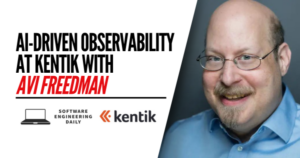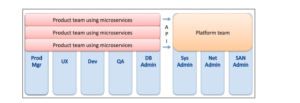Including Everyone in the Future of Analytic Applications

Google “dish soap for sensitive hands” and you will see advertisements for an array of relevant businesses selling dish soap. You may also see advertisements for gloves, sponges, and other related cleaning items. Initiatives and fundraising efforts may appear too. Google something else and the same thing will happen. This is Google Ads, and some call it the greatest disruption the marketing industry has ever seen. Google created billions of dollars of value by collecting data generated by its users, analyzing it, then displaying ads from companies to the relevant users. The consumer, advertiser, and Google all win.
But of course this is an over-simplification. Google doesn’t just collect data and look at it to make decisions. They use sophisticated machine learning techniques and artificial intelligence (AI) algorithms at every step of the flow. By injecting AI into every consumer-facing service and internal process, Google can understand their data, and therefore their customers and employees, better than any human or team of humans working without it. And they’re not the only company heavily using AI.
Thousands of companies are enhancing their decision making and consumer experiences with broad data collection and AI-driven analytics. Some more examples are chatbots, Uber routing drivers to riders, e-payments and financial services, video and shopping recommendations, facial recognition, digital assistants, and smart home products. According to Gartner, by 2022, at least 40% of new application development projects will have artificial intelligence co-developers on the team. The more that AI permeates our lives, the more consumers, vendors, and business alliances expect contextual and personalized experiences.
Companies who don’t currently use AI or only minimally use it need to first take a broad look at their customers, business, and industry. The companies benefiting most from AI put more of an architectural focus on the consumer’s role. Their programs capture a lot of data from users and then use that data to personalize content on the consumer side and inform decision making on the business side. How do current market dynamics affect the consumer’s need for information? How will the market you serve change over the next few years? Look at competition and what they are publicly doing too. Are there market opportunities through a better application experience? Certainly the business can make better decisions, possibly market-disrupting decisions, with a clearer view of consumer behavior.
The challenge for businesses that recently began using AI is involving the majority of their employees in implementing it throughout the organization. How can you use AI in all your user interfaces, services used by the user interfaces, and internal tools and business analysis when there might only be 1 data science team focused on super high priority projects? Moreover, how realistic is it to only hire people with advanced knowledge in AI and machine learning, or train your existing employees in these subjects? The slow adoption of sweeping AI in companies, despite the considerable investment companies are willing to make, is largely due to a shortage of trained individuals.
Software developers of every background and experience level now need to extend their skillset to understand how to use AI-driven analytics and put more emphasis on natural language query and generation, data storytelling, automated insights and embedded analytics. Using AI throughout the organization means involving people who are not specifically or originally a data scientist. The UI developer, for example, can become more familiar with consumer capabilities and embedded analytics. How can they build on their current skill set, with the frameworks they already use, to push personalized content or leverage natural language query to find the right information?
Business users like analysts and product managers can also benefit from being aware of new technical platforms that offer AI-powered and NLP-powered experiences. Dynamic storytelling or automated insights can displace a broken or manual process used by older analytics processes. Machine-learning driven forecasting can help business users make decisions on purchasing inventory, for example, with higher accuracy than the manual process of reviewing previous years’ data to manually calculate this years’ sales trajectory. Additionally, it’s probable that business vendors and other alliances will, if they haven’t already, enhance their own business capabilities with AI. Talking to them about their plans can give insight into creating future business synergy. Talking to innovative startups may also help develop plans for meeting the needs of the augmented consumer.
The AI market, such as the company Sisense, is responding to this supply shortage with innovations in the sub-field of AI known as Automated Machine Learning (AutoML). AutoML allows people without data science training to automate setting up, applying, and understanding machine learning insights for business problems. Sisense enables people of every background and experience level to infuse analytics in their work environment.
With the assistance of AutoML with Sisense, software developer teams can ask questions that artificial intelligence can answer without needing specially trained AI developers on the team. A user interface developer, for example, could design interfaces that go beyond their core purpose to capture data about the user’s preferences, mood, and behavior. They can work with backend developers to store that information in data tables, all with the intent to pass that information into AI models or to generate more personalized content. This is possible without large decision makers explicitly involving AI resources on that project. Instead, the UI developer is empowered with AutoML to provide more value to the business.
Once data is captured, other developers can speed up the task of preparing data for modeling with the Sisense Elastic Data Engine. This tool accomplishes all the necessary tasks of preparing complex data with rules like having the first letter of names be capitalized, excluding fake phone numbers like “000 000 0000”, only accepting business emails, etc. Beyond this, Sisense uses AI-powered grouping to automatically group similar values within given columns like “USA, US, United States.” These tools are available as ready-made point-and-click options or Excel-like functions so that less advanced users can prepare disparate datasets without composing individual SQL expressions (sisense). Disparate might be an understatement, as Sisense has data connectors for nearly 200 data sources.
As developers infuse applications with tools to capture data for AI modeling and analysis, business users and other analysts can easily apply many different ML-powered forecasting and trend functionalities to the data to see predictive movements in the future as well as deeper analysis of the past. Like the AI-assisted data preparation, the forecast modeling capabilities are presented in a menu-driven, point and click interface.
Sisense’s AI engine recommends the most effective ensemble configurations for analysts to use to reduce unnecessary experimental analysis of the data. Additionally, “Statistical outputs on each forecast model are available from the menu to increase explainability and trust in the forecast.” (Sisense).
Sisense Forecasting will soon enable the ability to include or exclude data for specific dates in response to the unusual business activity from Covid-19.
Business analysts can go beyond generating complex machine learning forecasts with Sisense Natural Language Query. This AI-driven tool lets users dictate appropriate data visualizations instantly. Ask Sisense NLQ to display income from the past 5 years as a bar graph, and after it automatically resolves ambiguity in your question from ‘income’ to ‘revenue’ to match the model, it will then generate the graph. Then change your question to get new results in a dynamic and quick way. The potential for exploration is extremely flexible and can adapt to fast-changing business landscapes quicker than manual processes. It even supports some forecast and trend capabilities, so you can use natural language to ask predictive questions.
Sisense has many other tools for understanding the forecasts it generates to inform quick and accurate business decisions. AutoML can really supercharge the adoption of AI throughout the entire organization without spending years training employees or hiring specialists. This helps the business internally, and also trickles down to the end-users to create more personalized experiences within applications and websites.
These are just some examples of how Sisense creates a broad integration across an organization. Every company is different and should evaluate the requirements for implementing AI within their specific context. If you can’t build AI-driven insights into your organization right away, work with developers to find opportunities to pilot or start small. Before blueprinting a whole program, it may help to start with a portal that gives personalized alerts and notifications, or embed analytics into an internal web page with simple html code.
A more advanced step could be embedding concise analytics at the point of where decisions or actions take place. Steps like this can help you develop a clear vision of your long term goals for your customer and internal operations. It also helps you determine practical information like estimating the development time needed for future projects, the skill requirements needed from your employees and what platforms, like Sisense, can help engage more people to use AI throughout the entire company. The ongoing maintenance and eventual upgrades for projects with embedded analytics is also important to learn about.
Big companies with endless resources have built entire product ecosystems around the principle of AI-driven analytics. Thanks to companies like Sisense, advanced AI capabilities are more accessible to everyone in an organization. The result is an organization that uses AI in every step of the workflow. The learning curve to implement AI broadly throughout a company is not eliminated by Sisense, but it is greatly reduced. Developers still need to learn new skill sets and view their solutions from a developer and analytical lens. Business analysts still need to look for more opportunities and use AI as a support beam, not a tell-all problem solver. Leveraging AI as broadly across the company as possible can certainly create new revenue channels, identify more business opportunities, and create the personalized experiences that consumers expect. The challenge is leveraging AI broadly, and the solution is using AutoML to include everyone in your digital transformation. Go here to learn more about Sisense.

























